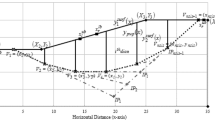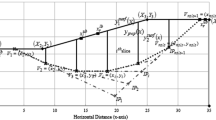Abstract
Searching for critical failure surface (CFS) with minimum factor of safety (FOS) of any slope require application of optimization. A particle swarm optimization (PSO) based MATLAB code is developed to search for CFS and associated minimum FOS of slopes by minimizing the objective function. The FOS against slope failure is determined by Bishop’s method based on limit equilibrium technique, which also serves as the objective function. With this goal, another computer code is developed in MATLAB to solve non-linear nature of equation of FOS. The effectiveness of developed code is investigated through study of different parameters such as swarm size, iteration count and slice numbers etc. The applicability of PSO is evaluated for homogeneous and layered slopes considering the effect of seepage and seismic loading.























Similar content being viewed by others
References
Arai K, Tagyo K (1985) Determination of noncircular slip surfaces giving the minimum factor of safety in slope stability analysis. Soils Found 25(1):43–51
Baker R (1980) Determination of the critical slip surface in slope stability computations. Int J Numer Anal Methods Geomech 4:333–359
Baker R, Garber M (1978) Theoretical analysis of the stability of slopes. Geotechnique 28:341–395
Bhattacharya RK, Satish MG (2007) Optimal design of a stable trapezoidal section using hybrid optimization techniques. J Irrig Drain Eng ASCE 1333(4):323–329
Bishop AW (1955) The use of slip circle in the stability analysis of slopes. Geotechnique 5(1):7–17
Bishop AW, Morgenstern N (1960) Stability coefficients for earth slopes. Geotechnique 10(4):164–169
Celestino TB, Duncan JM (1981) Simplified search for non-circular slip surface. In: Proceedings of 10th international conference on soil mechanics and foundation engineering. Stockholm Sweden, pp 391–394
Chen Z, Shao C (1983) Evaluation of minimum factor of safety in slope stability analysis. Can Geotech J 25(4):735–748
Cheng YM, Liang L, Chi SC, Wei WB (2007a) Particle swarm optimization algorithm for location of the critical non circular failure surface in two-dimensional slope stability analysis. Comput Geotech 34(2):92–103
Cheng YM, Liang L, Chi SC, Wei WB (2007b) Performance studies on six heuristic global optimization methods in the location of critical slip surface. Comput Geotech 34:462–484
Childs EC, George CN (1950) The permeability of porous materials. Proc R Soc 201:392–405
Clerc M, Kennedy J (2002) The particle swarm-explosion, stability and convergence in a multidimensional complex space. IEEE Trans Evol Comput 6(1):58–73
Corps of Engineers (1970) Slope stability manual. EM 1110-2-1902. Washington DC Department of the Army Office of the Chief Engineers
Eberhart RC, Kennedy J (1995) A new optimizer using particle swarm theory. In: Proceedings of 6th symposium on micro machine and human science, Nagoya, Japan, pp 39–43
Eberhart RC, Shi Y (1998) Comparison between genetic algorithms and particle swarm optimization. In: Poroto Saravanam WN, Waagen D, Eiben AE (eds) Evolutionary programming VII Berlin, pp 611–616
Eberhart RC, Simpson P, Dobbins R (1996) Computational intelligence PC tools. Academic Press Professional, Boston
Fellenius W (1936) Calculation of stability of earth dams. In: Proceedings of the second congress of large dams, vol 4, pp 445–463
Goh ATC (1999) Genetic algorithm based slope stability analysis using sliding wedge method. Can Geotech J 36:382–391
Goh ATC (2000) Search for critical slip circle using genetic algorithms. J Civ Eng Environ Syst 17(3):181–211
Greco VR (1996) Efficient Monte Carlo technique for locating critical slip surface. J Geotech Eng ASCE 122:517–525
Hajihassani M, Armaghani DJ, Kalatehjari R (2017) Applications of particle swarm optimization in geotechnical engineering: a comprehensive review. Geotech Geol Eng 36(2):705–722
Janbu N (1954) Applications of composite slip surfaces for stability analyses. In: Proceedings of the European conference on the stability of earth slopes, Stockholm, vol, 3, pp 39–43
Janbu N (1968) Slope stability computations. Soil mechanics and foundation engineering report. The Technical University of Norway, Trondheim, Norway
Kalatehjari R, Ali N, Ashrafi E (2011) Finding the critical slip surface of a soil slope with the aid of particle swarm optimization. In: Proceedings of 11th international multidisciplinary scientific geo conference, SGEM, Bulgaria, pp 459–466
Kalatehjari R, Ali N, Kholghifard M, Hajihassani M (2012) The application of particle swarm optimization in slope stability analysis of homogeneous soil slopes. Int Rev Model Simul 5(1):458–465
Kennedy J, Eberhart RC (1995) Particle swarm optimization. In: Proceedings of the IEEE international conference on neural networks, Perth Australia, pp 1942–1948
Kumar DN, Reddy JM (2007) Multipurpose reservoir operation using particle swarm optimization. J Water Resour Plan Manag ASCE 133(3):192–201
Lovbjerg M, Rasmussen TK, Krink T (2001) hybrid particle swarm optimizer with breeding subpopulations. In: Proceeding of the third genetic and evolutionary computation conference, San Francisco, pp 469–476
Lowe J, Karafaith L (1960) Stability of earth dams upon draw down. In: Proceedings 1st Pan-Am conference soil mechanics and foundation engineering, Mexico City, vol 2, pp 537–552
Lu ZS, Hou ZR, Du J (2006) Particle swarm optimization with adaptive mutation. Front Electr Electron Eng China 1(1):99–104
Malkawai AIH, Hassan WF, Sarma SK (2001) Global search method for locating general slip surface using Monte Carlo techniques. J Geotech Geo Environ Eng ASCE 127:688–698
McCombie PF, Wilkinson P (2002) The use of simple genetic algorithm in finding the critical factor of safety in slope stability analysis. Comput Geotech 29:699–714
Morgenstern NR, Price VE (1965) The analysis of the stability of general slip surfaces. Geotechnique 15(1):79–93
Nguyen VU (1985) Determination of critical slope failure surfaces. J Geotech ASCE 111:238–250
Ni Q, Deng J (2013) A new logistic dynamic particle swarm optimization algorithm based on rom topology. Sci World J. https://doi.org/10.1155/2013/409167
Parsopoulos KE, Vrahatis MN (2010) Particle swarm optimization and intelligence: advances and applications. Information science reference. Hershey, New York
Richards LA (1931) Capillary conduction of liquids through porous mediums. J Appl Phys 1:318
Sabhahit N, Sreeja J, Madhav MR (2002) Genetic algorithm for searching critical slip surface. Indian Geotech J 32(2):86–101
SEEP/W (2005) Seepage analyses software permitted for limited period of use by GeoSlope Office, Canada (lorin@geo-slope.com)
Segerlind LJ (1984) Applied finite element analysis. Wiley, New York
Shi Y, Eberhart RC (1998a) A modified particle swarm optimizer. In: Proceedings of the IEEE international conference on evolutionary computation, Anchorage AK, USA, pp 69–73
Shi Y, Eberhart RC (1998b) Parameter selection in particle swarm optimization. Lecture Notes in Computer Science, London, vol 1447, pp 591–600
Smith IM, Griffiths DV, Margetts L (2013) Programming the finite element method, 5th edn. Wiley, Hoboken
Spencer E (1967) A method of analysis of the stability of embankments assuming parallel inter-slice forces. Geotechnique 17(1):11–26
Yamagami T, Ueta Y (1988) Search for noncircular slip surfaces by the Morgenstern–Price method. In: Proceedings of 6th international conference on numerical methods in geomechanics, pp 1219–1223
Zhang Y, Gallipoli D, Augarde C (2013a) Parameter identification for elasto-plastic modelling of unsaturated soils from pressure meter tests by parallel modified particle swarm optimization. Comput Geotech 48:293–303
Zhang Y, Xiong X, Zhang Q (2013b) An improved self-adaptive PSO algorithm with detection function for multimodal function optimization problems. Math Probl Eng. https://doi.org/10.1155/2013/716952
Zolfaghari AR, Heath AC, McCombie PF (2005) Simple genetic algorithm search for critical non circular failure surface in slope stability analysis. Comput Geotech 32:139–152
Author information
Authors and Affiliations
Corresponding author
Rights and permissions
About this article
Cite this article
Himanshu, N., Burman, A. Determination of Critical Failure Surface of Slopes Using Particle Swarm Optimization Technique Considering Seepage and Seismic Loading. Geotech Geol Eng 37, 1261–1281 (2019). https://doi.org/10.1007/s10706-018-0683-8
Received:
Accepted:
Published:
Issue Date:
DOI: https://doi.org/10.1007/s10706-018-0683-8




